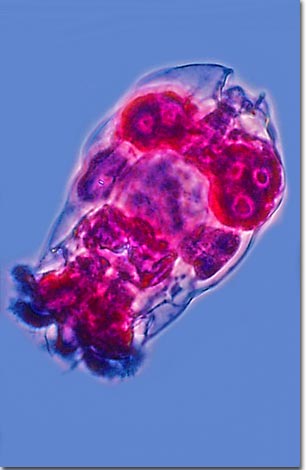Phase Contrast Image Gallery
Rotifers
Approximately 2,000 species of these microscopic invertebrates, common to freshwater habitats, occur worldwide. Rotifers were first discovered in the 1600s by Antoni van Leeuwenhoek, one of the first microscopists to study and describe microscopic organisms. Historically referred to as the Wheel Animalcule or Wheel Animal, rotifers were named for the shimmering rings of tiny beating cilia that draw food into their mouths.

Rotifers consist of only a few hundred cells, but are complex creatures considering that they are generally the same size as many protozoans (one-celled organisms). For the most part, they reproduce parthenogenically, females giving birth to self-cloned daughters. Males occur occasionally in some species, but have no mouth or digestive tract and die within hours or days. Rotifers can be free-living or sessile; a few are parasitic. Most live as individuals, but a few species live in colonies.
Although most commonly found in freshwater puddles, bogs, and ponds, rotifers can also be found in brackish and salt water environments. They can live in damp soil, damp moss, or any place that holds water for a period of time. As observed by Leeuwenhoek, they survive desiccation in the form of resting eggs, or cysts, reanimating within 24 hours of coming into contact with water. The tiny cysts can be carried by wind to any place that holds water (e.g. bird baths and gutters), where the rotifers will spring to life. Rotifers can live in harsh conditions, such as highly eutrophic (overly nourished) waters that kill most other microorganisms. They can also survive freezing and have been found in freshwater ponds in Antarctica (probably carried in dried form on bird feathers). Since there are no fish or other predators to eat the rotifers, they proliferate uncontrollably when the ice melts, coloring the water red.
Rotifers are valuable live food for larval fish and crustaceans, and commercial rotifer cultivation is a growth industry as aquaculture increases in popularity.
BACK TO THE PHASE CONTRAST GALLERY
